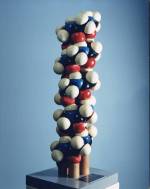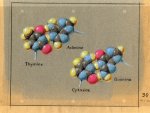|
It should be understood first that prior to 1953 very few researchers cared much about
DNA. Many were eagerly searching for the chemical nature of the gene, the master molecule
of heredity. It was clear by the 1920s that genes were located in chromosomes, dense
tangles of nucleic acid and protein in the nucleus of cells. But of the two major
components of chromosomes, protein and nucleic acid, most leading researchers favored
protein. Only proteins were thought to have the complexity and variety necessary for
determining the growth of an organism. Proteins, after all, were made of 20 or more
amino acids. They could exist in myriad forms, from hair and horn to enzymes and egg
whites. The nucleic acids, made of just four building blocks in monotonously regular
proportions, seemed stupid by comparison.
Linus Pauling, the world's leading structural chemist in 1950, believed that genes
were made of protein. He and Robert Corey, his chief assistant at Caltech, had spent
decades pinpointing the molecular structure of amino acids and protein subunits. Their
greatest triumph, in the spring of 1951, was the simultaneous publication of seven
papers detailing protein structures at the molecular level. Chief among them was the
alpha helix, a basic structure present in many proteins. Pauling was the first person
in history to outline basic protein structures at a very detailed molecular level.
He did it through hard work and daring, publishing the alpha helix structure only
after deciding to ignore one important bit of conflicting experimental evidence. As
it turned out, he was right to do so - further analysis showed that the data that
appeared to run counter to his structure could be explained in other ways.
|
|
Click images to enlarge

Space-filling model of the alpha-helix. 1951.

Pastel depiction of the DNA base pairs. October 1, 1963.
"A good example...is the case of the alpha helix. Pauling had set up a group to do
X-ray crystallography of the subunits of the proteins, and they got very precise data
that enabled him to build up the whole molecule from the parameters of the subunits.
As you know, he did this successfully in 1948 in London, but did nothing about it
because his final picture of the alpha helix in 1948 did not agree with the X-ray
diagram of the whole molecule....He then waited two years, until 1950, when the group
at I.C.I. in London published the first X-ray pictures of synthetic polypeptides.
These synthetic polypeptides did not have the anonymous reflection that Astbury's
fixtures had had, and could be accommodated to the alpha helix; and he then published
the paper. I think he was hoping to do the same thing with nucleic acids, because
enough had been published on the subunits for him to do it, but he was misled by the
erroneous pictures of the whole molecule."
|

